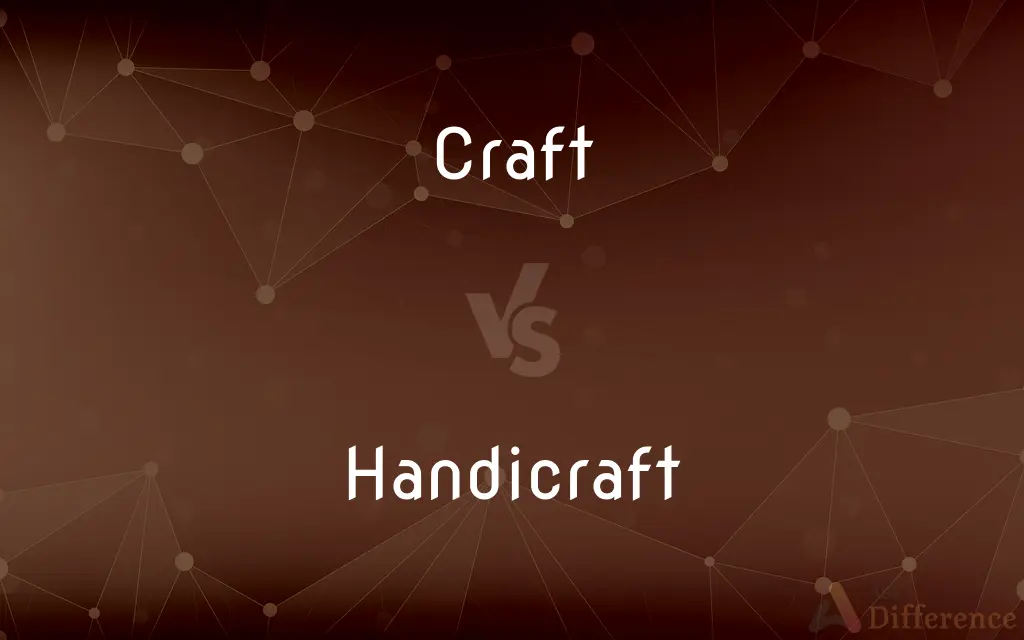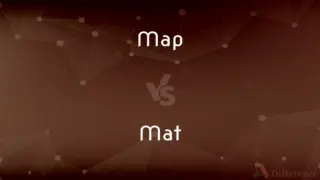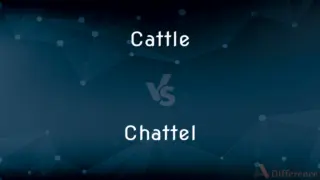Craft vs. Handicraft — What's the Difference?
By Urooj Arif & Fiza Rafique — Updated on February 29, 2024
Craft refers to a skill in making things by hand, emphasizing technique and artistry, while handicraft specifically denotes items made by hand, highlighting the cultural or artistic value of handmade goods.

Difference Between Craft and Handicraft
Table of Contents
ADVERTISEMENT
Key Differences
Craft encompasses a wide range of activities involving skillful creation, focusing on the techniques and materials used. It can include everything from woodworking to digital art, emphasizing the process of creation. Handicraft, on the other hand, is a subset of craft, specifically referring to items made by hand with traditional techniques, often carrying cultural or artistic significance.
Craft can be a hobby, profession, or both, involving both modern and traditional methods, handicraft often conveys a sense of heritage and authenticity. Handicrafts are typically associated with artisanal products, such as pottery, textiles, and jewelry, rooted in cultural traditions.
The value of craft lies in the skill and creativity of the maker, regardless of the medium. This value is evident in both contemporary and traditional forms. In contrast, the value of handicrafts is often enhanced by their cultural significance and the stories they tell, making them unique pieces of cultural heritage.
Technological advancements have expanded the boundaries of craft, introducing new tools and materials. Despite this, handicraft remains closely tied to traditional methods and materials, preserving age-old techniques passed down through generations.
The appreciation for craft and handicraft reflects a growing desire for sustainability and individuality in a mass-produced world. While craft offers endless possibilities across mediums, handicraft connects us to our cultural roots, offering a tangible link to the past.
ADVERTISEMENT
Comparison Chart
Definition
Skill in making things by hand, emphasizing technique.
Items made by hand, highlighting cultural/artistic value.
Focus
Technique, materials, and process.
Tradition, cultural significance, and manual labor.
Examples
Woodworking, digital art, pottery.
Traditional pottery, woven textiles, handmade jewelry.
Associated Value
Skill, creativity, and the quality of the finished product.
Cultural heritage, authenticity, and traditional methods.
Relation to Tradition
Can be both traditional and modern.
Primarily traditional and culturally rooted.
Compare with Definitions
Craft
The value in craft lies in the uniqueness and quality of the work produced.
Each piece she creates is a testament to her craft.
Handicraft
Handicraft refers to items made by hand, often with traditional methods.
The market was filled with handicrafts from local artisans.
Craft
Craft involves creating items by hand, focusing on the artistry and technique involved.
She honed her craft in ceramics over decades.
Handicraft
It emphasizes the cultural and artistic value of handmade goods.
Handicrafts often carry stories of the culture they come from.
Craft
Craft can be a hobby, a profession, or both, depending on the individual's engagement.
His hobby of woodworking eventually turned into a profitable craft.
Handicraft
The production of handicrafts helps preserve traditional skills.
Making these handicrafts has kept our traditional weaving techniques alive.
Craft
It encompasses a broad spectrum of activities, including traditional and modern techniques.
Digital design has become a highly respected craft.
Handicraft
Handicrafts are known for their authenticity and connection to heritage.
These handicrafts are a tangible link to our ancestral traditions.
Craft
Craft requires skillful use of tools and materials to create something.
Through her craft, she transforms raw clay into beautiful pottery.
Handicraft
Handicrafts are often created using natural, locally sourced materials.
The handicrafts were made using only the finest local wool.
Craft
A craft or trade is a pastime or an occupation that requires particular skills and knowledge of skilled work. In a historical sense, particularly the Middle Ages and earlier, the term is usually applied to people occupied in small scale production of goods, or their maintenance, for example by tinkers.
Handicraft
A trade requiring skill of hand; manual occupation; handcraft.
Craft
Skill in doing or making something, as in the arts; proficiency.
Handicraft
A handicraft, sometimes more precisely expressed as artisanal handicraft or handmade, is any of a wide variety of types of work where useful and decorative objects are made completely by one’s hand or by using only simple, non-automated related tools like scissors, carving implements, or hooks. It is a traditional main sector of craft making and applies to a wide range of creative and design activities that are related to making things with one's hands and skill, including work with textiles, moldable and rigid materials, paper, plant fibers,clay etc.
Craft
Make by hand and with much skill;
The artisan crafted a complicated tool
Handicraft
Activity involving the making of decorative domestic or other objects by hand
The traditional handicrafts of this region
Handicraft
Skill and facility with the hands.
Handicraft
A craft or occupation requiring skilled use of the hands.
Handicraft
An object that is crafted by skilled hands.
Handicraft
An artifact produced by handicraft.
Handicraft
A man who earns his living by handicraft; a handicraftsman.
Handicraft
A work produced by hand labor
Handicraft
A craft that requires skillful hands
Common Curiosities
What is the main difference between craft and handicraft?
Craft is a broad category involving skillful creation, while handicraft specifically refers to traditional items made by hand.
Are all crafts considered handicrafts?
No, not all crafts are considered handicrafts, especially those involving modern or non-traditional methods.
Can something be considered both a craft and a handicraft?
Yes, if it is made by hand using skillful techniques and carries cultural significance, it can be both.
Can modern techniques be used in handicraft?
While handicraft traditionally relies on manual techniques, some modern adaptations can exist, provided they respect the essence of the traditional methods.
How does one learn a craft or handicraft?
Learning can occur through formal education, apprenticeships, workshops, or self-teaching, depending on the craft or handicraft.
Can crafts and handicrafts be a profession?
Yes, many individuals turn their passion for craft or handicraft into a profession, selling their creations.
What role do crafts play in society?
Crafts contribute to cultural expression, economic activity, and the promotion of sustainability and individuality.
What makes handicrafts unique compared to mass-produced items?
Handicrafts are unique due to their handmade nature, cultural significance, and the story behind each piece.
Why is handicraft important?
Handicraft is important for preserving cultural heritage, traditional skills, and providing a unique, authentic product.
Is digital art considered a craft?
Yes, digital art is considered a craft due to the skill and creativity involved in creating art digitally.
What materials are commonly used in handicrafts?
Handicrafts commonly use natural, locally sourced materials such as wood, clay, fibers, and metals.
How do technological advancements impact crafts?
Technological advancements expand the possibilities for crafts, introducing new materials and methods.
What is the future of crafts and handicrafts?
The future looks promising, with a growing appreciation for handmade, authentic, and sustainable products.
How can one support the craft and handicraft industry?
Supporting local artisans, purchasing handmade products, and participating in craft fairs are ways to support the industry.
Are handicrafts environmentally friendly?
Many handicrafts are environmentally friendly, using sustainable materials and methods.
Share Your Discovery

Previous Comparison
Map vs. Mat
Next Comparison
Cattle vs. ChattelAuthor Spotlight
Written by
Urooj ArifUrooj is a skilled content writer at Ask Difference, known for her exceptional ability to simplify complex topics into engaging and informative content. With a passion for research and a flair for clear, concise writing, she consistently delivers articles that resonate with our diverse audience.
Co-written by
Fiza RafiqueFiza Rafique is a skilled content writer at AskDifference.com, where she meticulously refines and enhances written pieces. Drawing from her vast editorial expertise, Fiza ensures clarity, accuracy, and precision in every article. Passionate about language, she continually seeks to elevate the quality of content for readers worldwide.














































